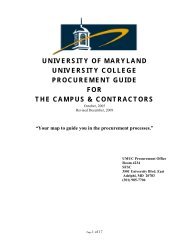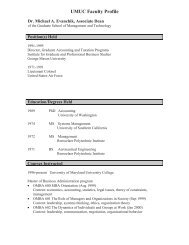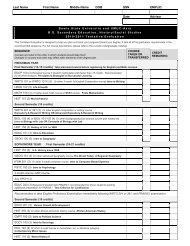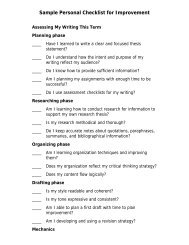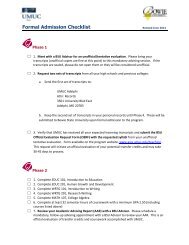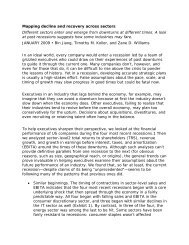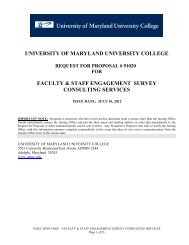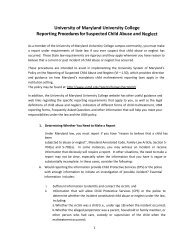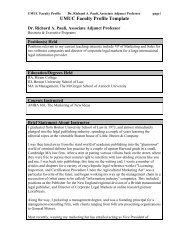COURSE DESCRIPTIONSEMBA 640 Strategic Global Marketing (6)(Formerly XMBA 603.) Prerequisite: EMBA 630. A study <strong>of</strong>business development strategies from the perspective <strong>of</strong> customerneeds and preferences. Focus is on the primacy <strong>of</strong> the customer inthe marketing process. Marketing is considered holistically as anorganization-wide process driving the marketing mix, marketingethics, innovation, competitive analysis, marketing informationsystems, pricing, global initiatives, e-commerce, customer pr<strong>of</strong>itabilityanalysis, and marketing return-on-investment.EMBA 650 Managing Business Operationsin a Global Environment (6)(Formerly XMBA 604.) Prerequisite: EMBA 640. An examination<strong>of</strong> the key strategic processes that allow modern global organizationsto function effectively. Focus is on how an organization is efficientlymanaged with the optimum utilization <strong>of</strong> resources (operations managementand enterprise resource planning), how vendors and suppliersare integrated seamlessly into the production process (supplychain management), and how customer interactions are facilitatedeffectively (customer resource management). Discussion covers howthese strategies and information technology developments are beingutilized to operate the modern organization. Topics also include theimportance <strong>of</strong> project management and managing change as keyingredients to an organization’s success.EMBA 660 Risk and Opportunity inGlobal Business Development (6)(Formerly XMBA 606.) Prerequisite: EMBA 650. The development<strong>of</strong> effective risk mitigation strategies for a sponsoring organizationto enter new international markets. External audits are conducted toidentify and assess the relative risks and opportunities <strong>of</strong> expandingoperations into specific country markets. Emphasis is on how thepolitical, regulatory, and economic policies <strong>of</strong> specific countries affectbusiness operations. Topics include the business impact <strong>of</strong> internationaltrading systems, regional trading relationships, and overseascountry environments. A required international study trip, focusedon trade agreements and overseas operations, is designed to increaseknowledge <strong>of</strong> and comfort with the new international markets.EMBA 670 Business Development Strategy andCapstone Project (6)(Formerly XMBA 607.) Prerequisite EMBA 660. The development<strong>of</strong> an international business development plan for a sponsoringorganization that integrates management techniques andmethodologies gained in previous study. Focus is on strategic decisionmaking in a globally competitive environment. Concepts,tools, and techniques from economics and the many other functionalbusiness disciplines are used. Although the framework andconcepts applied are geared toward creating business success in aglobal environment, they are equally applicable to strategic leadership<strong>of</strong> nonpr<strong>of</strong>it organizations and public agencies.ENER (Energy Resources Managementand Policy)ENER 603 Energy Infrastructure Management (3)An overview <strong>of</strong> U.S. and world energy infrastructure from the wellheadto the consumer. Topics include drilling, refining, transportation,and power generation and how the various energy grids fittogether in a vast network <strong>of</strong> energy delivery services. The vulnerabilitiesin the system <strong>of</strong> energy delivery are identified, and methodsto reduce these vulnerabilities are examined. Discussion coversenergy infrastructure issues in developing countries and the meansto leapfrog over existing technologies in order to develop an energyinfrastructure. Energy infrastructure risk and security issues areexplored, and measures to safeguard these infrastructures andminimize risk are introduced.ENVM (Environmental and WasteManagement)ENVM 641 Environmental Auditing (3)An examination <strong>of</strong> methods for attaining statutory, regulatory, andpermitting compliance. The protection <strong>of</strong> workers and other stakeholdersis also examined in the context <strong>of</strong> organizational, budgetary,and other constraints. Emphasis is on methods <strong>of</strong> defining auditingobjectives to meet organizational goals and <strong>of</strong> designing auditingprograms for effective compliance under each <strong>of</strong> the 12 major environmentalstatutes—including air, water, solid, and hazardous wastemanagement laws and pollution prevention initiatives.ENVM 643 Environmental Communications and Reporting (3)An overview <strong>of</strong> the range <strong>of</strong> communication practices required forenvironmental managers in the fulfillment <strong>of</strong> legal, regulatory, ethical,and organizational responsibilities. The various populationswith whom environmental managers must communicate and interact—includingplant supervisors, corporate executives, regulators,the legal community, civic groups, labor unions, and the media—are identified and examined. Discussion covers various types <strong>of</strong>communication, from decision memoranda to environmentalimpact statements, presentations <strong>of</strong> corporate environmental policiesbefore affected communities, and development/conveyance<strong>of</strong> technical evidence for obtaining permit variances.86GRADUATE <strong>CATALOG</strong> | 2008–2009
ENVM 644 New Technologies inEnvironmental Management (3)An overview <strong>of</strong> new waste management and waste minimizationtechnologies, including treatment technologies such as physicaland chemical treatment <strong>of</strong> hazardous wastes, bioreactors and bioremediation,and reverse osmosis and ultrafiltration. Review coversdisposal technologies, such as landfill design and operation, incineration,and encapsulation methods. Pollution prevention technologies,including process redesign and computer-aided process control,as well as the substitution <strong>of</strong> toxic materials, are also presented.ENVM 646 Environmental/Energy Lawand Policy Development (3)An examination <strong>of</strong> U.S. environmental and energy law and policy,including its development, implementation, and enforcement;legislative, executive, and judicial perspectives; and the roles andimpact these institutions have made on environmental and energylaw and policy. Leading laws and their ensuing policies, such asthe National Environmental Protection Act, the Clean Air Act,the Clean Water Act, the Resource Conservation and Recovery Act,the 1992 National Energy Policy Act, the FDR-era Federal PolicyAct, the Public Utility Holding Company Act, and the Carter-eraPublic Utility Regulatory Policy Act, are examined.ENVM 647 Environmental Risk Assessment (3)An overview <strong>of</strong> the basic concepts <strong>of</strong> risk assessment. Topicsinclude the four core parts <strong>of</strong> a risk assessment, as denoted bythe National Academy <strong>of</strong> Sciences: hazard assessment, doseresponseassessment, exposure assessment, and risk characterization.Methods <strong>of</strong> measurement and modeling are discussed,along with key questions concerning uncertainty. Differences inthe risk characterizations <strong>of</strong> substances under different use conditionsand legal requirements are studied. Significant case studiesserve to illustrate the assessment process.ENVM 648 Fundamentals <strong>of</strong> Environmental Systems (3)(For students lacking a strong science background or experiencein the environmental field.) An introduction to the basic concepts<strong>of</strong> environmental chemistry, physics, geology, and risk. Topicsinclude the gaseous, liquid, and solid effluents from various industrialactivities, as well as management methods and the statutoryand regulatory requirements <strong>of</strong> major federal environmental lawsaffecting this management. Discussion also covers fundamentalprinciples relating to the transport and fate <strong>of</strong> contaminants andindustrial wastes and the basic vocabulary <strong>of</strong> the field.ENVM 649 Principles <strong>of</strong> Waste Managementand Pollution Control (3)An introduction to various methods <strong>of</strong> waste management, includingwaste collection, transportation, recycling, treatment, and disposaland environmental monitoring. Focus is on hazardous and municipalsolid waste, pollution prevention techniques, and waste minimization.An introduction to the process <strong>of</strong> disposal-facility site selection,design, and operation is also provided.ENVM 650 Land and Water Resource Management (3)An introduction to the development <strong>of</strong> multiple-use resource managementstrategies and the role <strong>of</strong> public policy in land and waterresource management. Topics include free markets, market failure,and distributional equity issues; The Public Trust Doctrine; NativeAmerican Trust responsibilities; land use regulations; and enforcement<strong>of</strong> land and water restrictions, ex post liability schemes, andpublic purchase <strong>of</strong> private land and water rights.ENVM 651 Watershed Planning Management (3)An introduction to the concepts <strong>of</strong> watershed management andthe development <strong>of</strong> watershed-related management planning documents.The physical characteristics <strong>of</strong> watersheds and their role inmaintaining healthy environments and providing a natural resourceto society are examined. Focus is on examining management techniquesfor the conservation and maintenance <strong>of</strong> watersheds.ENVM 652 Principles <strong>of</strong> Air Quality Management (3)An overview <strong>of</strong> management techniques for addressing air qualityissues and managing air quality programs. Topics include air pollutionlaw; air pollutants and their sources; effects <strong>of</strong> air pollutionon health and welfare; sampling and analysis <strong>of</strong> air pollutants;standards, regulations, and enforcement systems; and qualityassurance principles.ENVM 653 Land Use Management (3)An introduction to the powers, process, and practice <strong>of</strong> managingthe patterns and land use implications <strong>of</strong> human settlement andthe built environment. Topics include where to build, where notto build, how to build, and when to build. Discussion also coversthe settlement history <strong>of</strong> the United States, as well as the constitutionaland legislative mandates for government, private-sector participants,and institutions that shape land use policy. Emphasis ison the role <strong>of</strong> local government. Land use and environmental communityplanning, as well as best practices in land use management,are examined.www.umuc.edu/grad 87
- Page 1 and 2:
GraduateSchool ofManagement& Techno
- Page 4 and 5:
Table of Contents457INTRODUCTION4 W
- Page 6 and 7:
Welcome to UMUCA UNIQUE INSTITUTION
- Page 8 and 9:
Preparing for Graduate StudyAs most
- Page 10 and 11:
Program OverviewDOCTORAL PROGRAMDoc
- Page 12 and 13:
DOCTORAL DEGREE PROGRAMDOCTOR OF MA
- Page 14 and 15:
MASTER’S DEGREE ANDCERTIFICATE PR
- Page 16 and 17:
MASTER’S DEGREE ANDCERTIFICATE PR
- Page 18 and 19:
MASTER’S DEGREE ANDCERTIFICATE PR
- Page 20 and 21:
MASTER’S DEGREE ANDCERTIFICATE PR
- Page 22 and 23:
MASTER’S DEGREE ANDCERTIFICATE PR
- Page 24 and 25:
MASTER’S DEGREE ANDCERTIFICATE PR
- Page 26 and 27:
MASTER’S DEGREE ANDCERTIFICATE PR
- Page 28 and 29:
MASTER’S DEGREE ANDCERTIFICATE PR
- Page 30 and 31:
MASTER’S DEGREE ANDCERTIFICATE PR
- Page 32 and 33:
MASTER’S DEGREE ANDCERTIFICATE PR
- Page 34 and 35:
MASTER’S DEGREE ANDCERTIFICATE PR
- Page 36 and 37:
MASTER’S DEGREE ANDCERTIFICATE PR
- Page 38 and 39: MASTER’S DEGREE ANDCERTIFICATE PR
- Page 40 and 41: MASTER’S DEGREE ANDCERTIFICATE PR
- Page 42 and 43: MASTER’S DEGREE ANDCERTIFICATE PR
- Page 44 and 45: MASTER’S DEGREE ANDCERTIFICATE PR
- Page 46 and 47: MASTER’S DEGREE ANDCERTIFICATE PR
- Page 48 and 49: MASTER’S DEGREE ANDCERTIFICATE PR
- Page 50 and 51: MASTER’S DEGREE ANDCERTIFICATE PR
- Page 52 and 53: MASTER’S DEGREE ANDCERTIFICATE PR
- Page 54 and 55: MASTER’S DEGREE ANDCERTIFICATE PR
- Page 56 and 57: EXECUTIVE PROGRAMSEver sharper comp
- Page 58 and 59: EXECUTIVE PROGRAMSCHIEF INFORMATION
- Page 60 and 61: DUAL DEGREE PROGRAMSMASTER OF BUSIN
- Page 62 and 63: DUAL DEGREE PROGRAMSMASTER OF BUSIN
- Page 64 and 65: DUAL DEGREE PROGRAMSNonprofit and A
- Page 66 and 67: DUAL DEGREE PROGRAMSMASTER OF DISTA
- Page 68 and 69: DUAL DEGREE PROGRAMSMASTER OF SCIEN
- Page 70 and 71: NONDEGREE TEACHEREDUCATION PROGRAMS
- Page 72 and 73: COURSE DESCRIPTIONSACCT (Accounting
- Page 74 and 75: COURSE DESCRIPTIONSAMBA 605 Economi
- Page 76 and 77: COURSE DESCRIPTIONSBIFS (Bioinforma
- Page 78 and 79: COURSE DESCRIPTIONSBTMN 670 Capston
- Page 80 and 81: COURSE DESCRIPTIONSDEPM (Distance E
- Page 82 and 83: COURSE DESCRIPTIONSDMGT (Doctoral S
- Page 84 and 85: COURSE DESCRIPTIONSEBUS 640 E-Techn
- Page 86 and 87: COURSE DESCRIPTIONSEDTC 620 Technol
- Page 90 and 91: COURSE DESCRIPTIONSENVM 670 Seminar
- Page 92 and 93: COURSE DESCRIPTIONSHCAD 630 Public
- Page 94 and 95: COURSE DESCRIPTIONSHSMN (Homeland S
- Page 96 and 97: COURSE DESCRIPTIONSINFA (Informatio
- Page 98 and 99: COURSE DESCRIPTIONSITEC 640 Informa
- Page 100 and 101: COURSE DESCRIPTIONSMRKT 606 Integra
- Page 102 and 103: COURSE DESCRIPTIONSOMDE 606 Costs a
- Page 104 and 105: COURSE DESCRIPTIONSPMAN 637 Project
- Page 106 and 107: COURSE DESCRIPTIONSSWEN 646 Softwar
- Page 108 and 109: COURSE DESCRIPTIONSTMAN 625 Economi
- Page 110 and 111: ADMINISTRATIONUniversity Systemof M
- Page 112 and 113: ADMINISTRATIONGraduate School ofMan
- Page 114 and 115: CONTACT INFORMATIONMASTER OF INTERN
- Page 116 and 117: CONTACT INFORMATIONOther Important
- Page 118 and 119: ADMISSION AND ENROLLMENT• Proof o
- Page 120 and 121: ADMISSION AND ENROLLMENTFinancial I
- Page 122 and 123: ACADEMIC AND ADMINISTRATIVEREQUIREM
- Page 124 and 125: ACADEMIC AND ADMINISTRATIVEREQUIREM
- Page 126 and 127: ACADEMIC AND ADMINISTRATIVEREQUIREM
- Page 128 and 129: SERVICES AND RESOURCESGeneral Infor
- Page 130 and 131: SERVICES AND RESOURCES• Possess a
- Page 132 and 133: SERVICES AND RESOURCESVeterans Bene
- Page 134 and 135: SERVICES AND RESOURCESuate school d
- Page 136 and 137: FACULTYAwwad, Ahmad A.Adjunct Assis
- Page 138 and 139:
FACULTYBravo, Kathleen M.Adjunct As
- Page 140 and 141:
FACULTYCost, Richard S.Adjunct Assi
- Page 142 and 143:
FACULTYFitzpatrick, Edmund W.Adjunc
- Page 144 and 145:
FACULTYHalstead, John M.Adjunct Ass
- Page 146 and 147:
FACULTYKavoossi, MasoudAdjunct Asso
- Page 148 and 149:
FACULTYMadison, David L.Adjunct Ass
- Page 150 and 151:
FACULTYMustafa, MuhammadAdjunct Pro
- Page 152 and 153:
FACULTYRabin, Bonnie R.Adjunct Prof
- Page 154 and 155:
FACULTYShirani, Ashraf I.Adjunct Pr
- Page 156 and 157:
FACULTYViamonte, GailChair, Teacher
- Page 158 and 159:
UNIVERSITY POLICIESStudent Classifi
- Page 160 and 161:
UNIVERSITY POLICIESReligious Observ
- Page 162 and 163:
UNIVERSITY POLICIESsubsequent semes
- Page 164 and 165:
UNIVERSITY POLICIESV. DisclosuresUM
- Page 166 and 167:
APPENDICESAppendix A: Program-Caree
- Page 168 and 169:
APPENDICESProgram-Career Map, contd
- Page 170 and 171:
APPENDICESProgram-Career Map, contd
- Page 172 and 173:
APPENDICESProgram-Career Map, contd
- Page 174 and 175:
APPENDICESProgram-Career Map, contd
- Page 176 and 177:
APPENDICESProgram—Career Map, con
- Page 178 and 179:
INDEXAAcademic advising, 126Academi
- Page 180 and 181:
INDEXDDatabase systems technologyce
- Page 182 and 183:
INDEXHomeland security managementce
- Page 184 and 185:
INDEXResidency determination, 115,
- Page 186 and 187:
NOTES184GRADUATE CATALOG | 2008-200
- Page 188:
ABOUT UMUCUniversity of Maryland Un




